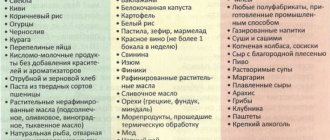Colic is a sharp, paroxysmal pain sensation in the intestines that occurs in 70% of babies in the first months of life. Typically, attacks occur suddenly at 3-4 weeks of life and disappear without a trace at the age of 3-4 months. Colic in infants is not a disease; its occurrence is caused by changes in the body, adaptation to a new diet, conditions and environment. Therefore, you should not panic if they start, because this is an absolutely natural and inevitable process. It does not require special treatment, but it is still recommended to show the newborn to a pediatrician, because painful spasms in the intestines can be a sign of a disease, for example, dysbiosis.
So, let's figure out how to recognize intestinal colic in a newborn, what to do and how to alleviate his condition.
What is colic
Colic most often occurs in newborns in the first month of life. There are often cases when this happens earlier or later than the specified period. They usually end by six months.
Not all babies suffer from intestinal spasms. For some, this condition passes painlessly - the mucous membrane is quickly populated by microflora. Other children experience little pain, so parents don't always notice the symptoms.
In most cases, colic in newborns at night is accompanied by severe cramps, especially after the last meal.
Infants experience the following symptoms:
- restlessness, frequent awakenings and crying;
- the child presses his legs to his body, clenches his hands into fists;
- the face turns red;
- upon completion of an attack of abdominal pain, an act of defecation occurs, accompanied by the release of gases.
Such manifestations are typical for all newborns, so the pediatrician can quickly make a diagnosis. The condition is not pathological - it is a normal physiological process.
Parents often ask pediatricians what the difference between so-called gas and colic is. In the first case, this is the process of gas formation in the lower parts of the digestive tract with the formation of air bubbles. They cannot get out, so the baby experiences discomfort and cries. His condition is alleviated by the introduction of a gas tube.
Colic is a spasm in the intestines, which can be accompanied by gas formation and is not always eliminated by the described method, since the gases leave, but the spasm remains.
What to do
In some situations, intestinal colic in breastfed newborns can be prevented by following certain measures:
- a nursing mother must follow a diet (her diet should not contain foods that contribute to increased gas formation: peas, beans, beans, white cabbage, pickled vegetables, milk, kefir, apples, pears, grapes, black bread, baked goods, chocolate);
- before feeding, the baby should be placed tummy down on a hard surface for 5-10 minutes, and then lightly stroke the tummy clockwise, which helps to expel gases and improve intestinal motility;
- after feeding, the baby should be supported in an upright position for about 10 minutes so that he burps air (such easy actions reduce the likelihood of colic in the abdomen);
- limit pacifier sucking;
- in case of lactase deficiency, the baby is transferred to low-lactose or lactose-free milk formulas (read how to transfer a child to another formula).
Reasons for appearance
There are physiological and pathological causes of spasms in the intestines in infants.
The first include the following factors:
- improper grip of the nipple, sucking, position of the child’s body while eating;
- content in the mother’s diet of foods that lead to excessive gas formation (cabbage, legumes);
- maternal fatigue, depression, anxiety;
- drinking foremilk without creating hindmilk, because the woman takes the breast too early or the baby falls asleep quickly;
- incorrectly selected mixture or violation of the rules for its preparation;
- a large amount of air swallowed by the newborn, which moves into the gastrointestinal tract.
Diseases that can lead to intestinal spasms:
- enterocolitis – inflammation of the mucous membrane of the small and large intestines;
- lactase deficiency, allergy to dairy products in the mother or baby;
- cystic fibrosis - production of excessively thick mucus by the glands of the respiratory system, gastrointestinal tract, etc.;
- dysbacteriosis – a violation of the microflora of the lower gastrointestinal tract;
- hypovitaminosis – lack of vitamins in the body of the mother or baby;
- intestinal infection;
- Crohn's disease is a chronic inflammatory process that affects all membranes (mucous, submucosal, muscular) of the gastrointestinal tract.
Pathological causes of spasms are rare. Basically, the condition is associated with the body’s reaction to the colonization of microflora.
Parents often notice that spasms occur in the baby in the evening and at night. This is explained as follows:
- consumption of gas-forming foods by the mother for dinner before the last feeding;
- due to fatigue, the mother may not hold the baby correctly during night feeding;
- fatigue of the infant, who experiences severe pain, reaching its peak in the evening, due to lack of sleep;
- features of the autonomic nervous system of a child, which is most sensitive in the evening and at night.
Important! Since infants eat every 2-3 hours, cramps can occur at any time of the day. They usually intensify before defecation.
Causes
Let's consider the main factors contributing to the occurrence of intestinal colic in an infant:
- immaturity of the gastrointestinal tract (insufficient amount of enzymes in the child’s body that help digest breast milk or formula);
- lactase deficiency (the inability of a child’s body to digest milk sugar contained in breast milk);
- improper nutrition of a woman when breastfeeding (consumption of foods that increase peristalsis and cause bloating, colic);
- incorrect feeding process (air entering the child's body during feeding, as a result of too fast sucking, improper latching of the breast, incorrectly selected nipple and feeding bottle);
- overfeeding a newborn with artificial feeding (overeating causes increased gas formation);
- violation of food preparation technology during artificial feeding (the mixture was not diluted according to the instructions);
- intestinal infections, dysbiosis (these diseases may be accompanied by painful spasms).
How to help your baby
There are several ways to alleviate the condition of a newborn with colic without the use of medications:
- Change body position. If the baby usually lies on his back, he can be turned onto his stomach or side (a blanket should be placed under his back to prevent him from rolling over).
- Carry in a column. This technique will be most effective immediately after eating, so that gases from the esophagus and stomach escape without reaching the intestines. You can also carry a baby in a column every night while crying, so that he calms down.
- Place the baby on the mother's stomach. The feeling of warmth will stop the spasms. Another option is to place a heating pad with warm water on the baby's stomach, after measuring the temperature so as not to burn him.
These methods are effective if the baby experiences minor spasms. For excessive muscle contractions, it is recommended to use medications.
Most often, pediatricians advise using:
Important! The listed medications are classified as herbal medicines, so it is recommended to first consult with a pediatrician. If a child is prone to allergies, he may experience rashes, redness, and an inflammatory reaction.
Doctors often recommend the use of drugs that populate the intestines with beneficial microflora - probiotics:
Can colic in a newborn baby be permanent?
As a rule, colic begins with rare (1-2 times a week), short-lasting attacks (15-20 minutes), which stop after the passage of gas or stool. Subsequently, the frequency and duration of colic increase, sometimes reaching 8 hours. An alarming sign of long-term colic may be the overlap of other symptoms such as foamy stools and constipation. In this case, additional examination is required to exclude diseases that have similar features.
Can colic occur during feeding?
Attacks of colic are quite clearly associated with feeding, appearing approximately 20-30 minutes after it, mainly in the evenings. Sometimes an attack of pain can occur during a meal, prompting the baby to refuse the breast or bottle. This is due to the fact that milk, entering the intestines, increases its peristalsis. Swallowing air during feeding may also be a possible cause. In this case, you need to hold the newborn upright or massage the tummy. You should not give your baby the breast if he doesn’t want it until the attack passes. Otherwise, excessive intrusiveness may lead to rejection of the breast even in the absence of colic. Sometimes a baby's anxiety during feeding can be caused by oral thrush.
Colic. How to understand that a child has colic. How to deal with them
In the first months of life, the baby often cries. According to various studies, at the age of up to 6 weeks, a child cries on average 125 minutes a day; at 10-12 weeks, the duration of daily crying is reduced to 68 minutes.
One of the most common causes of baby crying is infant colic. This condition is diagnosed in 8-40% of children (rates vary greatly among different populations). Caucasian children are most susceptible to colic, and the number of cases increases with distance from the equator. Colic occurs equally in boys and girls, regardless of whether they are breastfed or bottle-fed, or born full-term or premature.
Causes of colic
The causes of the pathology are still unknown. Scientists have been studying the phenomenon of colic for many years, building various hypotheses about their occurrence. Let's consider the most likely hypotheses.
"Gastrointestinal Theories"
This group includes several causes of colic associated with the functioning of the baby’s gastrointestinal tract:
- feeding disorders - overfeeding or underfeeding the baby, swallowing air when eating, poor regurgitation of air, etc.
- intolerance to cow's milk protein - indeed, this problem occurs in some children, but not in all, as many believe
- poor absorption or digestion of lactose obtained from breast milk or formula
- features of intestinal microflora
- intestinal immaturity
"Biological Theories"
Biological theories are based on the following assumptions about the nature of colic:
- colic occurs due to hormonal characteristics of infants, for example, with increased levels of serotonin and motilin
- the condition can be triggered by exposure to nicotine - it has been proven that the incidence of colic is significantly higher in children whose mothers smoked during pregnancy and breastfeeding
- Colic can be an early manifestation of migraine - for example, adolescents who suffer from colic in infancy are more susceptible to migraine attacks. There is also a similarity between the symptoms of colic and migraine: the frequency of symptoms, the pronounced beginning and end of the episodes.
"Psychosocial theories"
Proponents of these theories argue that the occurrence of colic is associated with the emotional state of the mother and child. For example, an increased incidence of infant colic was diagnosed in anxious mothers prone to depression and emotional stress in early pregnancy.
At the moment, scientists have not come to a clear conclusion about the true cause of infant colic. It is most likely that a combination of several of the listed factors leads to this condition.
How can you tell if your baby has colic?
As for the manifestations of colic, they are easy to distinguish from the symptoms of other pathologies:
1. Have a clear beginning and a clear end. Each episode of colic begins and ends suddenly, usually in the evening and first half of the night.
2. The sound of crying during colic is much higher and louder, more like a scream. In this case, the child has an expression of severe pain on the face, as well as redness and blueness of the nasolabial triangle.
3. Crying can alternate with capriciousness; while crying, the child practically does not react to the mother’s actions and cannot calm down with hugs, rocking, etc.
4. During colic, the baby’s stomach is tense, bloating may be noted, the back is arched, the fists are clenched tightly, the legs and arms are pressed to the stomach.
5. After passing stool or gas, the baby can calm down.
6. Outside of an episode of colic, the child is active and cheerful, there are no signs of illness.
Colic does not require special treatment and goes away on its own by 3-4 months. Occasionally the condition can last up to six months.
According to research, colic may have certain consequences. For example, in adolescents who suffer from colic in the first months of life, migraine headaches are more often diagnosed. They are more susceptible to tantrums at an older age.
Parents of infants suffering from colic are more likely than other families to be not fully satisfied with their marriage and have unresolved family conflicts in the first months after the birth of the child. However, by the age of 3, these indicators smooth out and are approximately comparable with other families.
How to cope with colic?
Parents experiencing infant colic for the first time inevitably wonder about methods to calm their baby. There is no universal method that would suit all children. However, there are plenty of techniques you can try to calm your baby, and perhaps one method will produce the results you expect. These methods are free, completely safe and can reduce the level of anxiety and feelings of helplessness in parents:
1. Take your child for a ride in a stroller down the street or in a car. Rocking while riding can calm your baby. If the method is effective, go outside or get into the car 20-30 minutes before the expected episode of colic.
2. Take the child in your arms, hold him close, rock him, stroke him, sing songs. At the same time, you need to try to be as calm as possible so that the baby does not transmit a feeling of anxiety.
3. Try noise therapy: turn on a hairdryer, vacuum cleaner, hood, washing machine or other noisy appliances. It’s a paradox, but such sounds can calm many babies.
4. Offer your child a pacifier.
5. Give your child a warm bath.
6. Gently stroke the baby's belly and make several circular rotations.
7. Try not to overfeed the baby, maintaining an interval between feedings of 2-2.5 hours.
Over a long period of studying colic, many assumptions have arisen about ways to eliminate the pathology. Let's try to give a scientific assessment of each method.
- Changes in diet Changing your usual diet can only be recommended if other methods have not brought results. For formula-fed babies, you can try replacing regular formula milk with hydrolyzed formula. If there is no effect within 1 week, return the previous mixture. Breastfeeding mothers should follow a hypoallergenic diet (limit consumption of dairy products, eggs, wheat and nuts). If the method is ineffective, resume your usual diet.
- Probiotics Research data on the use of probiotics for infant colic is conflicting and cannot be offered as a treatment. A detailed analysis of 4 studies showed that the use of drugs containing lactobacilli L. reuteri does not prevent an attack of colic, but only reduces the duration of crying after 21 days of use by 25 minutes, compared with placebo. In the USA, a DNA analysis of probiotics was carried out, according to which the contents of the preparations often do not correspond to the types of bacteria indicated on the packaging, and therefore can be harmful to the baby’s health.
- Lactase and simethicone preparations These drugs are not recommended for use in colic due to the lack of proven effectiveness.
- Herbal preparations Remedies cannot be recommended due to lack of proven effectiveness. The possible benefit does not exceed the possible harm (herbal products often contain ingredients not declared on the packaging). Also, using herbal teas can significantly reduce the consumption of breast milk or formula.
- Homeopathic remedies The drugs have no proven effectiveness and cannot be recommended for the treatment of infant colic. According to research, products often contain undeclared ingredients in pharmacological and even toxic doses.
And finally, let’s dwell on the important points.
If you are trying to calm a crying child, but no methods help, you feel nervous tension and are ready to scream, put the child in the crib and let him cry for 10-15 minutes. At this time, try to calm down yourself: listen to pleasant music, talk with loved ones, try to be distracted by household chores. Once you feel emotionally calm, try repeating the steps to calm your baby.
No matter how stressed or exhausted you are, never shake, throw or hit your baby. Such actions do not solve the problem, but only aggravate the situation and expose the baby to serious danger.
How to distinguish colic from hunger
In theory, everything is simple: a hungry baby should calm down if you give him a breast or a bottle of formula. In practice, there are other options: the quantity or quality of milk has changed, the formula is chosen incorrectly, and the baby does not receive enough of the necessary substances. Malnutrition is indirectly indicated by changes in bowel and bladder bowel movements. The baby begins to cry immediately after feeding and cries almost constantly, becomes lethargic, and sleeps poorly. Hungry babies can get carried away by sucking fists, fingers and anything that fits in their mouths. With prolonged malnutrition, a decrease in the rate of weight gain is observed. For more information about how much a child should eat at a given age and how to determine whether a child is full or not, read special articles.
How to distinguish colic from lactase deficiency
Pain in the tummy can be a symptom of lactase deficiency (in everyday life it is sometimes mistakenly called lactose deficiency). A deficiency of the enzyme that breaks down milk sugar is indicated by:
- loose, foamy stools with lumps, bowel movements occurring more than 10 times a day. The smell is pronounced sour. Artificial babies may have constipation, but the structure of the stool has the same characteristic features: clear lumps, then foamy liquid.
- weight loss.
- disruption of the intestinal microflora.
Lactase deficiency does not exclude colic; on the contrary, its manifestations only intensify.
How to determine if a newborn is colicky
Focusing only on the baby's crying and restlessness, it is sometimes difficult to determine whether colic has passed or not. After all, at the age when they pass, teething begins, which also causes a lot of anxiety for parents. Therefore, the main criterion that you can focus on is the baby’s tummy. If crying is accompanied by a tight and swollen tummy, flatulence, then colic still bothers the baby. When the baby’s tummy is soft, it means that the colic has already passed, and the reason for the crying must be sought elsewhere.
Approximately 30% of infants do not suffer from colic. Mothers of boys, for unknown reasons, face this problem much more often than mothers of girls. If you are unlucky and your blood is one of the children whose infancy is overshadowed by this mysterious physiological feature, you will have to be patient and learn to eliminate seizures from your beloved little person. In addition to colic medications, the following may help you:
Colic in a newborn: what to do? How I overcame colic in my baby
What if I told you that there is no such thing as colic in newborns? It is a myth! An attempt to explain the difficult to explain. And this myth is actively and persistently supported by pharmaceutical companies that produce “healing” remedies for colic.
This bold opinion was expressed by Italian pediatrician Costantino Panza, and was supported by many colleagues. I read his article too late, when I experienced colic in my children and came to the understanding that they were not telling us something.
I did not believe in the existence of this mysterious disease that attacks most babies, if only because, from the experience of many mothers I know, it became clear: medications for colic do not solve the problem. I wonder why? Is it because newborns cry not because of colic?
Why then do children cry inconsolably in the first months of life?
The only way a newborn baby can convey any information to others is by crying. The little ones don't know any other language. And they cry with their whole bodies: bending over, clenching their fists, tucking their legs. Indeed, it looks very much like they are in pain. Especially similar to abdominal pain.
Why would a child have a tummy ache?
The most common opinion is gases. Too much gas. Sorry, I get fart sometimes too. But it never hurt. Unpleasant, causes discomfort, but not painful. Why then should newborns get sick?
Gastrointestinal tract not ready? For what? To mother's milk? Do you really think that such a perfect mechanism as the human body can react negatively to the only fuel that the manufacturer has provided exclusively for it? Well, nature, with all its perfection, could not allow such a mistake!
If so-called colic occurred exclusively in children fed formula, one would still be able to believe that the gastrointestinal tract is not ready for it. And since this scourge occurs in both infants and artificial babies, the theory about the unpreparedness of the gastrointestinal tract is shattered.
It’s not uncommon for young mothers to be criticized for not eating properly while breastfeeding. Many pediatricians, in an attempt to cure colic in infants, transfer poor, already tired and exhausted mothers to a strict diet. They motivate this by the fact that cabbage eaten by the mother creates an increased amount of gases in the child’s intestines! Well, how's that? It's not even logical. How can gases pass from the mother's intestines into breast milk? But no way. Milk is a derivative product of maternal blood plasma. That is, what enters the mother’s blood in high concentrations will also end up in mother’s milk. But the gases don’t get into the blood at all.
Even WHO says that during breastfeeding, mothers should follow a varied diet as much as possible in order to provide themselves with all the necessary vitamins and minerals.
It seems to me that the most plausible version is that the cause of colic in newborns is the immaturity of their nervous system. Then let's call a spade a spade! What kind of colic is this! It is simply crying as the newborn's only tool to convey a certain discomfort. Crying, which simply “unloads” the child from all the stress that he has accumulated during the day. After all, everyone knows that the notorious colic appears in the evening. Why did it happen? Certainly not because the unlucky mother ate a plate of borscht at lunch.
The baby, after nine months of living in a quiet, dark and cozy hole, where he heard only muffled sounds from outside and the steady beating of his mother’s heart, was suddenly catapulted into a new world. And this world seems hostile to him. Bright light, sharp and loud sounds, unusual smells, the constant need to get food for yourself... And also mom... where is mom? You can no longer hear her heart beating and the blood rushing through her vessels. Only sometimes, when you have to suckle to get enough, the mother takes the baby in her arms again, and he again hears the usual knocking sound. And he calms down.
When my first son was born, I felt like Yuri Gagarin on his first flight into space. I didn’t understand anything. And, of course, his “colic” was accepted as part of the “newborn” package.
The son cried, we put him belly down on his father’s hand (he did not fit on his mother’s).
My son continued to cry, I tried to put him to my chest. He calmed down for a while, and then cried again.
Then we resorted to the last resort - a gas outlet tube. I don't think it's worth explaining how it works. The son was releasing gases (how could it be otherwise, anyone would have done this if they had inserted a tube into him in that very place). We relaxed with a sense of accomplishment, and our son also calmed down for a while. Sometimes.
The next step was swimming. We filled a warm bath and plunged our screaming happiness into it. And the son fell silent. Instantly. Why do you think? Now I can say with confidence: he felt in a familiar environment. Like once upon a time, when he was still in the womb, enveloped in warm amniotic fluid.
And if we also turned on the hairdryer, which, according to experts, resembles in sound and intensity the noise made by blood running through the mother’s vessels, then the son fell asleep. Right in the bath.
We created a familiar environment for him and suddenly everything stopped hurting him? Or maybe nothing hurt? He was just tired, he wanted to again experience that feeling of security and peace that his mother gave him during pregnancy.
This idea was confirmed by the fact that as soon as we got our son out of the water, he again became hysterical. Does it hurt again? Don't think.
The problem of colic was solved in only one way: we put the child to sleep. They put my son in pajamas, closed the curtains and put him to bed for the night. Even if it was too early in our opinion. The son fell asleep gratefully. And we fell exhausted on the sofa.
When we noticed a pattern in the child’s behavior and determined that feeding (read: closeness with mom), bathing (read: recreating the familiar environment) and putting him to bed (read: stopping exposure to external stimuli) always calmed him down, we came up with our own remedy for colic.
What is this? Regular sling. Yes, I bought a sling and began to carry my son in it all the time. We gave up the stroller altogether. The baby was always on me. What he received:
- closeness to my mother (we cooked, cleaned, went for walks and bought groceries in a sling);
- recreation of a familiar environment (tightly rolled, the beating of mother’s heart is constantly heard, her smell and warmth are nearby);
- cessation of exposure to external stimuli (at any moment the son could hide from light and noise in a sling).
Since the sling appeared in our lives, our son no longer cried in the evenings. Well, maybe sometimes, but it was not at all the same uncontrollable and inconsolable crying.
By the time our youngest daughter arrived, we were already fully equipped: I started using a sling while still in the maternity hospital. I think you have already guessed that my daughter did not suffer from colic at all. Coincidence? Don't think.
With the second child, the sling acquired additional value - both hands are free, you can take care of the older one, take him by the hand on the way to the park, for example.
I want to warn you: there will definitely be those who disagree. You will certainly meet a grandmother who will ask why you put, for example, a dog in your bosom. Once in a store, having abandoned her numerous purchases, an elderly lady chased me. When she caught up with me, she asked with horror on her face: “Is he breathing?” She was referring to my daughter, snoring peacefully in her sling while we shopped for groceries.
Prepare to sweat. A lot of. Especially if the child was born in the summer. With both children, I always carried a change of clothes with me, both for them and for myself. Agree, a wet T-shirt on a young woman looks attractive only in films. On a nursing mother, covered with children, this is a so-so sight.
You will have to learn to bend over, squat, and eat without dropping food on yourself. This comes with experience and daily training.
A newborn baby who is calm and smiling even in the evening is worth it.










